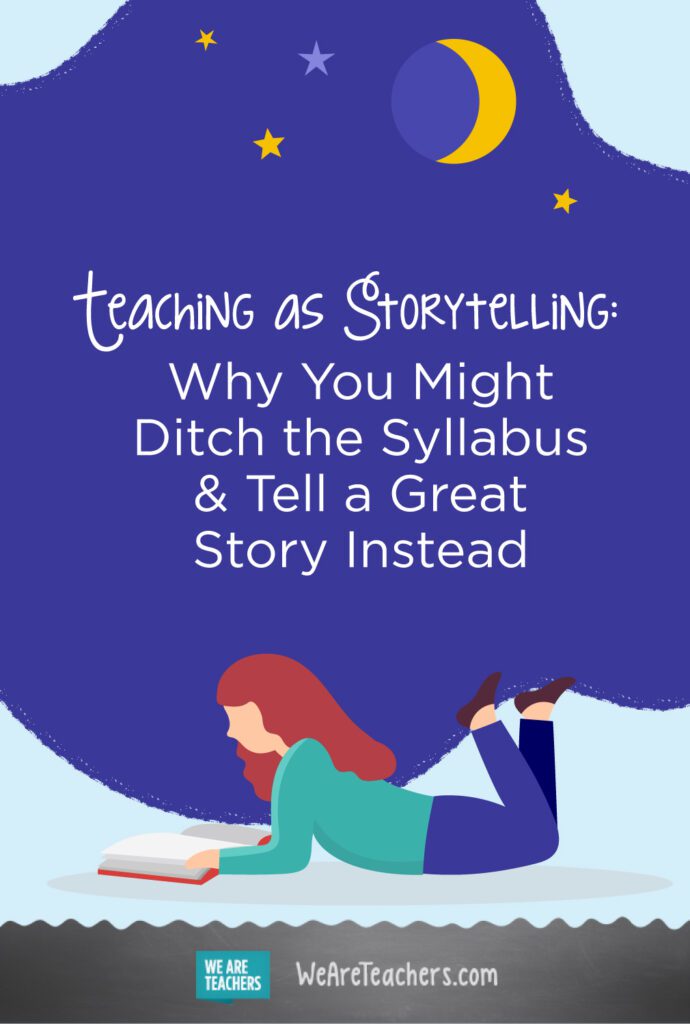The start of this school year must be compelling. In 2021, the last thing students need is to be handed a list of rules, due dates, and topics. They need meaningful connections to curricular content and to one another. So, let’s turn a sleepy syllabus into an exciting story. Let’s help students see themselves as active participants in an unfolding, larger context.
Here is an example of how a seventh-grade history teacher opened her first class using storytelling:
What does it mean to be Texan? And how has this changed over time? How do nature and culture impact who you are and how you see the world? The story of Texas shows how where we live impacts how we live and that new groups bring about new ideas that often lead to conflict as well as integration and changes to worldview. We’ll explore these ideas with American Indian groups, European colonization, Mexican Independence, and finally, the Texas Revolution─with each new context further developing our understanding of human-environment interaction as well as culture, change, and identity.
And here is the way a middle school mathematics teacher framed the year ahead as a classic Hero’s Journey:
Call to Adventure: Are you ready to solve the world’s problems? Can we use mathematics to simplify complexity and find amicable solutions?
Trials and Tribulations: Reasoning through complexity is no easy task. Can we use our number sense and critical thinking to creatively communicate our ideas?
The Abyss: We will face known and unknown variables and quantities changing at different rates. We might have to adjust our perspective to find the best angle or approach to have the best chance of convincing people we can help the world.
The Return: How have you made the complex seem simple? Are you able to maximize space, establish the best investment, or tell someone their chances of winning the lottery? How will your new reasoning and wisdom help you solve the world’s problems?
In both these examples, teachers use narrative elements─character and story arc─to help students see the big picture of what they are going to learn. The benefits are many and include giving students a context, the Why of the study, an active role in the quest to know more, clarity on what’s expected of them, and a reassuring reminder that the learning process has ups and downs, and that’s more than OK.
The Call of Stories
Since the beginning of time, stories have kindled the human spirit. Stories teach us who we are and how to literally survive and thrive. Through storytelling, important information is handed down from generation to generation. Revered medical school professor and author Robert Coles examined in The Call of Stories the ways that stories help shape our imagination and morality and help us articulate the narrative of our own lives. More recently, cognitive scientist Daniel Willingham (2009) provides four reasons why stories are a motivating structure for students.
- Stories are easy to comprehend because they’re a structure familiar to everyone.
- Stories are engaging because they demand frequent medium-difficulty inferencing that encourages us to constantly think about their meaning.
- We remember stories because they have a causal structure, and that structure helps us retain information.
- Stories have emotional resonance because they humanize abstract ideas (Willingham, 2009, p. 66-75).

Tools to Stay the Course
Take a moment to remember a time when you were dizzy with overwhelm in a class, or in a formidable book passage, or facing an assignment. You probably thought something along the lines of, There is no way I’m going to get through this… It’s an awful feeling. As teachers, we can ease this anxiety by letting students know that two seemingly conflicting things are true about learning:
- Learning is not linear; it occurs through a complex set of experiences that require us to question what we understand, persevere as we experience confusion or cognitive dissonance, and ultimately gain new understandings that inevitably raise new questions and uncertainties. In short, disequilibrium is part of learning, not an intellectual shortcoming.
- There are structures to lean on as learners and tools that help us navigate the high seas of complex concepts. Consider how the following structures might help your students orient themselves at the outset of your course. Select one to write the story of your course. Observe how it plays out; try various structures over time to discover which ones engage learners the most.
Potential Structures for the Story of Your Course
1. Chronology
The most familiar and straightforward way to structure your course is to arrange it in chronological order. However, just because it’s familiar doesn’t mean it has to be boring! By exploring how the events of one period or movement evolve and flow into the next, you’ll be challenging students’ ability to understand how cause and effect relationships shape history, paradigms, and scientific eras. When students have the ability to place a particular method or discovery within a broader timeline, they can think more deeply and abstractly about its context. Whether we’re inferring like a historian, hypothesizing like a scientist, or composing like a journalist, the ability to trace our thinking back to a particular moment in history is a useful one.
2. Thesis/Antithesis/Synthesis
Although we believe the world is becoming increasingly complex, it’s never been a simple place. History and science are filled with competing theories and belief systems that rose to prominence, were challenged, and either replaced or synthesized into new theories that drove humanity forward. Famous historian Georg Hegel had an entire theory of history and philosophy based on such a pattern.
What we’re suggesting is certainly an over-simplification but can provide some inspiration for creating a narrative for your course. For example, each quarter, your students could explore a conceptual relationship that seems to make a concrete claim— think, systems require order and cohesion to flourish sufficiently. Your students could read books that create that theme, study empires or nation states at the height of their powers, or evaluate healthy biomes and ecosystems. Your next unit would then challenge that principle, showing students that when systems become stagnant or inflexible, they can become oppressive or break down, for example. Then your students could read texts with a similar theme, learn about the breakdown of empires, or study how human pollution is damaging various ecosystems. The overall idea is to lead students towards a clear conclusion, then challenge them by complicating their understanding with each new unit. In addition to providing an organizing logic and sequence to your course, this will help push students to always challenge their assumptions.
3. Hero’s Journey
Joseph Campbell was an anthropologist who studied and spent time with cultures all over the world. Though each culture was different in many ways, much of their stories followed a similar arc, a structure Campbell called the monomyth, and we’ve come to know as the hero’s journey. In fact, countless of our favorite movies today, from Star Wars to Moana, follow a similar structure. Due to its ubiquity, it’ll be quickly recognizable to students. Below is a quick overview of how it can provide you with a structure for your course.
- The Call to Adventure: What kind of adventure or quest will your students be embarking on in your course? How can you invite them to join in and leave their comfort zone?
- Trials & Tribulations: What kind of challenges will they encounter in your course? What skills will they need to succeed? What knowledge? How can your course build these competencies in such a way that students know they’ll need them to succeed on their journey?
- The Abyss: Consider having students launch into a massive project or self-directed unit of study once they’ve acquired all the skills necessary. How can they use the knowledge they’ve gained thus far in your course to conquer a problem in their lives?
- The Return: How can you close your year in a way that promotes student reflection and spreads the word about their work over the course of the year? The end of the year is a time for students to internalize and share what they’ve learned.
Sentence Stems for Thinking About Teaching as Storytelling
The following sentence stems can help you brainstorm the story of your course.
This course is about…
This year we will…
We will begin by ___, then we’ll _____, and finally, we’ll ____ all in order to understand that ____.
Try it out and see how it sets a direction for your course and a different tone for the year!
This blog is an adapted excerpt from Learning That Transfers, by Julie Stern, Krista Ferraro, Kayla Duncan, and Trevor Aleo. For more ways to engage students, check out their suite of online courses.
What are your thoughts on teaching as storytelling? Please share in the comments!
Plus, be sure to subscribe to our newsletters for more articles like this.


